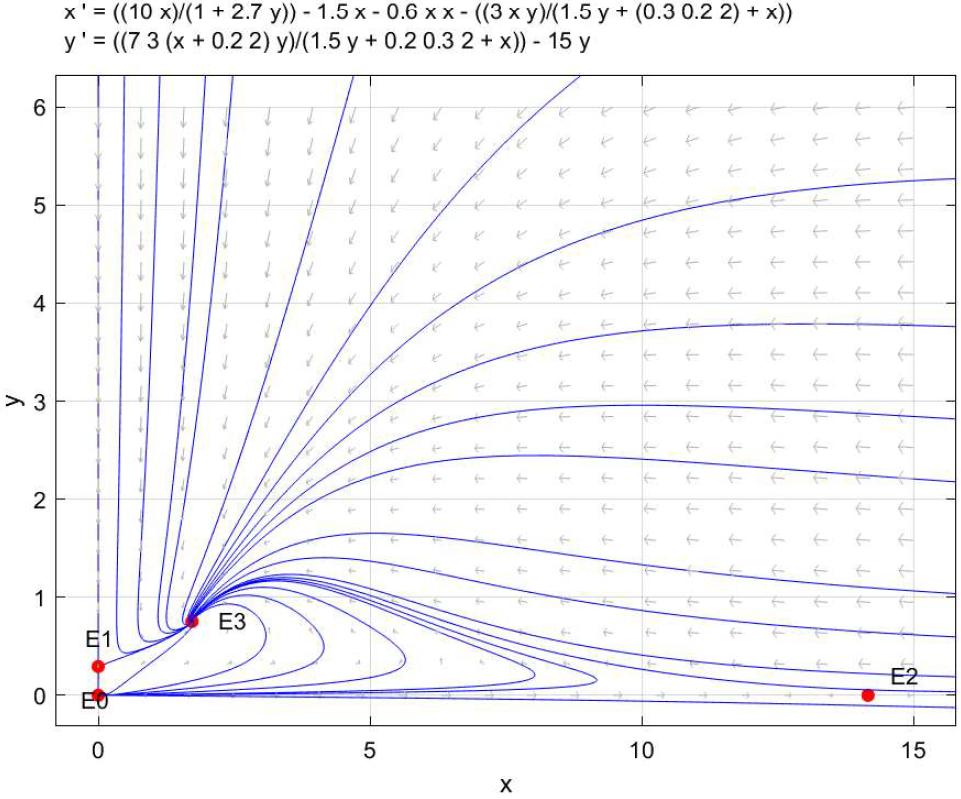Dynamic Analysis of an Ecological Model with Fear Effect on Prey and Additional Food for Predator Using Ratio-Dependent Functional Response
Main Article Content
Abstract
This study discusses the dynamic analysis of a predator-prey model that incorporates the fear effect on prey and supplemental food for predators, using a ratio-dependent functional response. The fear effect reduces the prey’s intrinsic growth rate due to behavioral changes under predation risk, while supplemental food enables the predator to survive even when prey density is low. The analysis begins with the formulation of the model equations, followed by the identification of equilibrium points, linearization of the system, and local stability analysis using eigenvalues. Numerical simulations are carried out using \textit{Matcont} and \textit{Pplane} to verify the analytical results and to illustrate the system’s qualitative behavior. The model parameters are based on the interaction between elk (\textit{ELK}) as prey and wolves (\textit{Canis lupus}) as predators. The results reveal four equilibrium points: $E_0=(0,0)$ is an unstable nodal source, $E_1=\left(0,\dfrac{nA(c\gamma - e\alpha)}{em}\right)$ and $E_2=\left(\dfrac{r-a}{b},0\right)$ are unstable saddle points, while the coexistence equilibrium $E_3=(x^*, y^*)$ is a stable spiral sink under certain parameter conditions. Bifurcation analysis with respect to the fear parameter $f$ and the supplemental food parameter $A$ reveals the occurrence of a transcritical bifurcation, where two equilibrium branches exchange stability. The system tends toward the equilibrium point $E_1$ when either $f$ or $A$ exceeds a critical threshold, indicating that predators can persist even as prey populations decline significantly. These findings suggest that predator survival is not solely dependent on prey availability but also influenced by the availability of alternative food sources and the intensity of the prey’s fear response.
Article Details

This work is licensed under a Creative Commons Attribution-NonCommercial-NoDerivatives 4.0 International License.
References
Bailey DF, Boyce WE, DiPrima RC, Braun M. Elementary Differential Equations and Boundary Value Problems. vol. 84. 8th ed. USA: John Wiley & Sons, Inc; 1977.
Zanette IY, Clinchy M. Ecology of fear. Current Biology. 2019;29(9):R309–13.
Mondal S, Maiti A, Samanta GP. Effects of Fear and Additional Food in a Delayed Predator-Prey Model. Biophysical Reviews and Letters. 2018 dec;13(04):157–77.
Wang X, Zanette L, Zou X. Modelling the fear effect in predator-prey interactions. Journal of Mathematical Biology. 2016 nov;73(5):1179–204.
Shao Y. Global stability of a delayed predator-prey system with fear and Holling-type II functional response in deterministic and stochastic environments. Mathematics and Computers in Simulation. 2022;200:65–77.
Saha S, Pal S, Melnik R. Analysis of the impact of fear in the presence of additional food and prey refuge with nonlocal predator-prey models. Ecological Modelling. 2025 jun;505:111103.
Ulfa HM, Suryanto A, Darti I. Dynamics of Leslie-Gower Predator-Prey Model With Additional Food for Predators. International Journal of Pure and Applied Mathematics. 2017;115(2):199–209.
Hunsicker ME, Giannelli L, Bailey KM, Buckel JA, Wilson White J, Link JS, et al. Functional responses and scaling in predator-prey interactions of marine fishes: Contemporary issues and emerging concepts. USA: National Oceanic and Atmospheric Administration (NOAA); 2011.
Beddington JR. Mutual Interference Between Parasites or Predators and its Effect on Searching Efficiency. The Journal of Animal Ecology. 1975 feb;44(1):331.
Haldane JBS. Enzymes. Monographs on Biochemistry. London: Longmans, Green, and CO.; 1930.
Brown KM, Varza D, Richardson TD. Life Histories and Population Dynamics of Two Subtropical Snails (Prosobranchia:Viviparidae). Journal of the North American Benthological Society. 1989;8(3):222–8.
Arditi R, Ginzburg LR. Coupling in predator-prey dynamics: Ratio-Dependence. Journal of Theoretical Biology. 1989 aug;139(3):311–26.
Zhao L, Wang J, Zhang Y. Fear effects in predator-prey interactions: A review and prospect. Ecological Modelling. 2022;472:110128.
Smith JA, Suraci JP, Clinchy M, Crawford A, Roberts D, Zanette LY, et al. Fear of the human 'super predator' reduces feeding time in large carnivores. Proceedings of the Royal Society B: Biological Sciences. 2017;284(1857):20210035.
Ripa RR, Franzese J, Premoli AC, Raffaele E. Increased canopy seed-storage in post-fire pine invaders suggests rapid selection mediated by fire. Basic and Applied Ecology. 2020;45:76–85.
Kumar V, Das P, Roy S. Alternative food and predator-prey dynamics in disturbed habitats. Ecological Modelling. 2023;480:110311.
Collins SL, Nippert JB, Blair JM, Briggs JM, Blackmore P, Ratajczak Z. Fire frequency, state change and hysteresis in tallgrass prairie. Ecology Letters. 2021;24(4):636–47.
Sakai S. Why are deleterious mutations maintained in selfing populations? An analysis of the effects of early- and late-acting mutations by a two-locus two-allele model. Journal of Theoretical Biology. 2022;533:110956.

